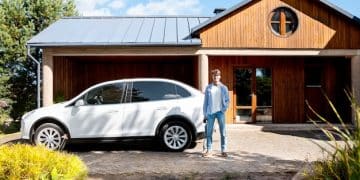New Car Incentives 2025: Rebates & Tax Credits Guide

New car incentives in 2025, including rebates and tax credits, can significantly reduce the cost of purchasing a vehicle; understanding eligibility requirements and application processes is crucial for maximizing savings.
Navigating the world of new car buying can be complex, but understanding available incentives can save you a significant amount of money. In 2025, numerous programs offer rebates and tax credits to encourage consumers to purchase new vehicles, particularly those that are fuel-efficient or electric. This guide will explain how to find and claim available new car incentives in 2025, allowing you to make an informed decision and potentially lower the overall cost of your new car.
Understanding Federal Tax Credits for Electric Vehicles
One of the most significant incentives available is the federal tax credit for electric vehicles (EVs). This credit aims to promote the adoption of electric cars by making them more affordable for consumers. However, understanding the intricacies of this credit is essential to ensure you qualify and receive the maximum benefit.
Eligibility Requirements for the Federal Tax Credit
To be eligible for the federal tax credit, the electric vehicle must meet certain criteria. These requirements are designed to ensure that the incentive is targeted towards vehicles that align with the government’s energy and environmental goals.
Firstly, the vehicle must be new; used EVs are not eligible for the federal tax credit. Additionally, the vehicle must have a battery capacity of at least 7 kilowatt-hours (kWh). This requirement ensures that the incentive benefits vehicles with a meaningful electric driving range.
How to Claim the Federal Tax Credit
Claiming the federal tax credit for electric vehicles involves a few key steps. The process is relatively straightforward, but it’s important to follow the instructions carefully to avoid any issues.
The first step is to purchase an eligible electric vehicle from a qualified dealer. Ensure that the dealer provides you with all the necessary documentation, including the vehicle’s VIN (Vehicle Identification Number) and other relevant details. Keep this documentation safe, as you’ll need it when filing your taxes.
- Verify the vehicle’s eligibility on the IRS website.
- Obtain necessary documentation from the dealer.
- File IRS Form 8936 with your tax return.
- Keep records of the purchase for future reference.
The federal tax credit for electric vehicles is a valuable incentive that can make owning an EV more affordable. By understanding the eligibility requirements and following the correct steps to claim the credit, you can maximize your savings and contribute to a cleaner environment. Always consult with a tax professional for personalized advice tailored to your specific circumstances.
State and Local Rebates for New Cars
In addition to federal incentives, many state and local governments offer rebates for new car purchases, especially for electric and hybrid vehicles. These rebates can provide additional savings, making environmentally friendly vehicles even more attractive.
Finding State-Specific Rebates
Finding state-specific rebates can be done through several online resources, including government websites and databases dedicated to energy and environmental incentives. These resources provide comprehensive information on available rebates, eligibility requirements, and application processes.
Start by visiting the official website of your state’s energy or environmental agency. These websites often have sections dedicated to incentives and rebates for electric and hybrid vehicles. Look for programs that offer cash rebates or other financial incentives for purchasing a new car.
Examples of State and Local Rebate Programs
Several states have implemented robust rebate programs to encourage the adoption of electric and hybrid vehicles. These programs vary in terms of the amount of the rebate offered, eligibility requirements, and application processes.
California, for example, offers the Clean Vehicle Rebate Project (CVRP), which provides rebates for eligible electric, plug-in hybrid, and fuel cell vehicles. The amount of the rebate varies depending on the type of vehicle and the applicant’s income level. To be eligible, applicants must meet certain income requirements and reside in California.

Exploring state and local rebates for new cars can lead to significant savings, especially when combined with federal tax credits. By researching available programs and understanding the eligibility requirements, you can maximize your savings and contribute to a more sustainable transportation system.
Manufacturer Incentives and Discounts
Car manufacturers often provide their own incentives and discounts to attract buyers. These incentives can take various forms, including cash rebates, low-interest financing, and special lease deals. Understanding these manufacturer-specific incentives can help you negotiate a better price on your new car.
Types of Manufacturer Incentives
Car manufacturers offer a wide range of incentives to entice buyers. These incentives can be categorized into several types, each with its own advantages and disadvantages.
One common type of manufacturer incentive is a cash rebate. This is a direct discount on the purchase price of the vehicle, which can be applied at the time of sale. Cash rebates are often promoted as a way to lower the out-of-pocket cost of buying a new car.
How to Find Manufacturer Incentives
Finding manufacturer incentives requires some research, but it’s well worth the effort. There are several reliable sources of information that can help you uncover available incentives and discounts.
Start by visiting the manufacturer’s website. Most car manufacturers have a section dedicated to incentives and special offers. Look for information on cash rebates, financing deals, and lease offers. Pay attention to the fine print, as there may be eligibility requirements or restrictions.
- Check manufacturer websites for current offers.
- Visit car dealerships and inquire about incentives.
- Use online car-buying platforms to compare deals.
- Subscribe to email newsletters for updates.
Exploring manufacturer incentives and discounts is a crucial step in the new car buying process. By understanding the types of incentives available and knowing where to look for them, you can negotiate a better deal and save money on your new car.
Negotiating the Best Price: Combining Incentives
Negotiating the best price for a new car involves more than just haggling over the sticker price. It also requires understanding how to combine various incentives to maximize your savings. By strategically stacking incentives, you can significantly reduce the overall cost of your new car.
Strategies for Combining Incentives
Combining incentives effectively requires careful planning and research. It’s important to understand which incentives can be stacked and which ones are mutually exclusive. Some incentives can be combined without any restrictions, while others may have specific requirements or limitations.
Start by identifying all the incentives for which you are eligible. This includes federal tax credits, state and local rebates, and manufacturer incentives. Make a list of each incentive, along with the amount of the potential savings and any eligibility requirements.
Real-World Examples of Incentive Stacking
To illustrate how incentive stacking works in practice, let’s look at a few real-world examples. These examples demonstrate how consumers have combined various incentives to save money on their new car purchases.
Consider a buyer who purchases a new electric vehicle that qualifies for the federal tax credit of $7,500. In addition, the buyer is eligible for a state rebate of $2,500 and a manufacturer incentive of $1,000. By stacking these incentives, the buyer can reduce the overall cost of the vehicle by a total of $11,000.

Negotiating the best price for a new car often involves combining various incentives to maximize your savings. By understanding how to stack incentives strategically, you can significantly reduce the overall cost of your new car and drive away with a better deal.
Navigating the Fine Print and Hidden Restrictions
While incentives can significantly lower the cost of a new car, it’s crucial to read the fine print and understand any hidden restrictions. Many incentives come with specific eligibility requirements, limitations, and expiration dates. Failure to understand these details could result in disappointment and lost savings.
Common Restrictions on Incentives
Incentives often come with a variety of restrictions that can affect your eligibility and the amount of savings you can receive. These restrictions are designed to ensure that the incentives are targeted towards specific groups or types of vehicles.
One common restriction is income limits. Many state and local rebates, as well as some federal tax credits, have income limits that applicants must meet to be eligible. These income limits are intended to ensure that the incentives benefit low- and moderate-income individuals and families.
How to Avoid Common Pitfalls
Avoiding common pitfalls when claiming incentives requires careful attention to detail and thorough research. By understanding the potential challenges and taking steps to mitigate them, you can increase your chances of successfully claiming the incentives for which you are eligible.
Start by reading the fine print of each incentive carefully. Pay attention to eligibility requirements, limitations, and expiration dates. If you have any questions, contact the agency or organization offering the incentive for clarification.
Navigating the fine print and hidden restrictions of incentives is a crucial step in the new car buying process. By understanding the potential challenges and taking steps to mitigate them, you can avoid common pitfalls and maximize your savings
Future Trends in New Car Incentives for 2025 and Beyond
As the automotive industry continues to evolve, so too will the landscape of new car incentives. Several trends are expected to shape the future of incentives in 2025 and beyond, including a greater emphasis on electric vehicles, increased funding for charging infrastructure, and innovative incentive programs.
Expected Changes in Federal and State Programs
Several changes are expected in federal and state programs that could impact new car incentives in the coming years. These changes reflect evolving policy priorities and the need to adapt to the changing automotive landscape.
One potential change is an increase in the federal tax credit for electric vehicles. As the cost of EVs continues to decline, policymakers may consider increasing the amount of the credit to make EVs even more affordable. This could help accelerate the adoption of electric cars and reduce greenhouse gas emissions.
The Role of Technology and Innovation
Technology and innovation are expected to play a significant role in shaping the future of new car incentives. As the automotive industry continues to embrace new technologies, policymakers may consider incentives that promote innovation and support the development of advanced vehicle technologies.
- Incentives for advanced safety technologies
- Support for autonomous vehicle development
- Incentives for renewable energy integration
The future of **new car incentives in 2025** and beyond is likely to be shaped by evolving policy priorities, technological advancements, and innovative incentive programs. By staying informed about these trends, consumers can make informed decisions and take advantage of the available incentives.
| Key Point | Brief Description |
|---|---|
| 💰 Federal Tax Credit | Up to $7,500 for eligible EVs; check requirements on IRS website. |
| 🌎 State Rebates | Vary by state; check your state’s energy agency website. |
| 🚗 Manufacturer Incentives | Cash rebates, low-interest financing; check manufacturer websites. |
| ✅ Combining Incentives | Strategically stack incentives for maximum savings. |
Frequently Asked Questions
▼
The federal tax credit for electric vehicles is a tax incentive offered by the U.S. government to encourage the adoption of electric cars. It can be up to $7,500 for eligible vehicles and helps to lower the overall cost of buying an EV.
▼
State-specific rebates for new cars can be found on your state’s energy or environmental agency website. Look for sections dedicated to incentives and rebates for electric and hybrid vehicles, and review the eligibility requirements.
▼
Yes, manufacturer incentives can often be stacked with other rebates, such as federal tax credits and state rebates. However, it’s important to check the terms and conditions of each incentive to ensure that they can be combined.
▼
Common restrictions on new car incentives include income limits, vehicle eligibility requirements, and expiration dates. Some incentives may also be limited to specific regions or vehicle types, so it’s essential to review the fine print.
▼
To negotiate the best price, start by researching all available incentives and understanding the eligibility requirements. Then, negotiate the price of the car before applying any incentives, and finally, stack the incentives to reduce the overall cost.
Conclusion
Understanding and leveraging new car incentives in 2025 can significantly reduce the cost of purchasing a new vehicle. By staying informed about federal tax credits, state and local rebates, and manufacturer incentives, consumers can make informed decisions and take advantage of the available savings. Always read the fine print, combine incentives strategically, and negotiate the best possible price to maximize your benefits.





